This is “Evaluating the General Environment”, section 3.2 from the book Strategic Management: Evaluation and Execution (v. 1.0). For details on it (including licensing), click here.
For more information on the source of this book, or why it is available for free, please see the project's home page. You can browse or download additional books there. To download a .zip file containing this book to use offline, simply click here.
3.2 Evaluating the General Environment
Learning Objectives
- Explain how PESTEL analysis is useful to organizations.
- Be able to offer an example of each of the elements of the general environment.
The Elements of the General Environment: PESTEL Analysis
An organization’s environment includes factors that it can readily affect as well as factors that largely lay beyond its influence. The latter set of factors are said to exist within the general environment. Because the general environment often has a substantial influence on an organization’s level of success, executives must track trends and events as they evolve and try to anticipate the implications of these trends and events.
PESTEL analysisThe examination of political, economic, social, technological, environmental, and legal factors and their implications for an organization. is one important tool that executives can rely on to organize factors within the general environment and to identify how these factors influence industries and the firms within them. PESTEL is an anagram, meaning it is a word that created by using parts of other words. In particular, PESTEL reflects the names of the six segments of the general environment: (1) political, (2) economic, (3) social, (4) technological, (5) environmental, and (6) legal. Wise executives carefully examine each of these six segments to identify major opportunities and threats and then adjust their firms’ strategies accordingly (Figure 3.1 "PESTEL").
Figure 3.1 PESTEL
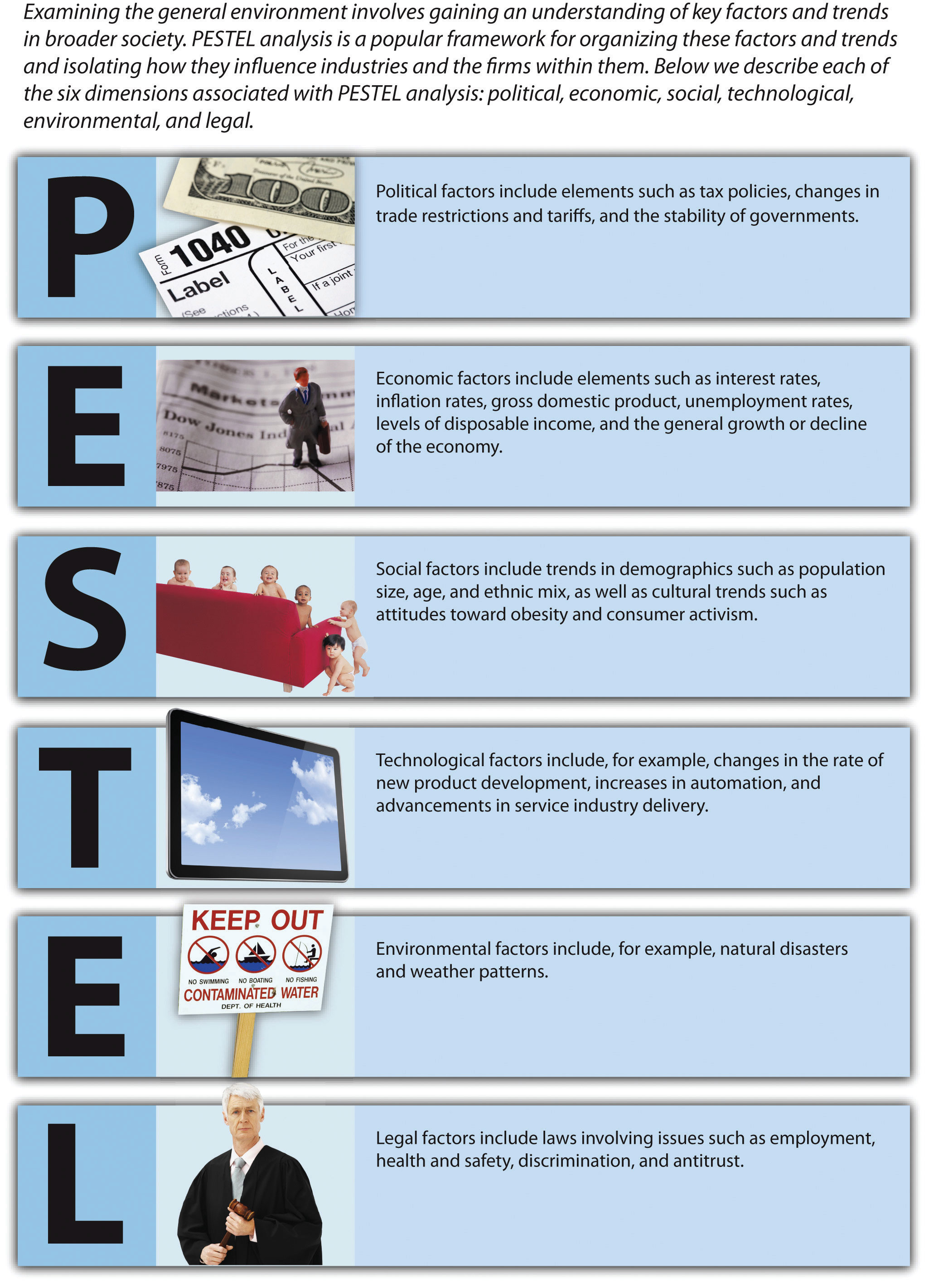
© Thinkstock
P Is for “Political”
The political segmentThe portion of the general environment that involves governments. centers on the role of governments in shaping business. This segment includes elements such as tax policies, changes in trade restrictions and tariffs, and the stability of governments (Figure 3.2 "Political Factors"). Immigration policy is an aspect of the political segment of the general environment that offers important implications for many different organizations. What approach to take to illegal immigration into the United States from Mexico has been a hotly debated dilemma. Some hospital executives have noted that illegal immigrants put a strain on the health care system because immigrants seldom can pay for medical services and hospitals cannot by law turn them away from emergency rooms.
Figure 3.2 Political Factors
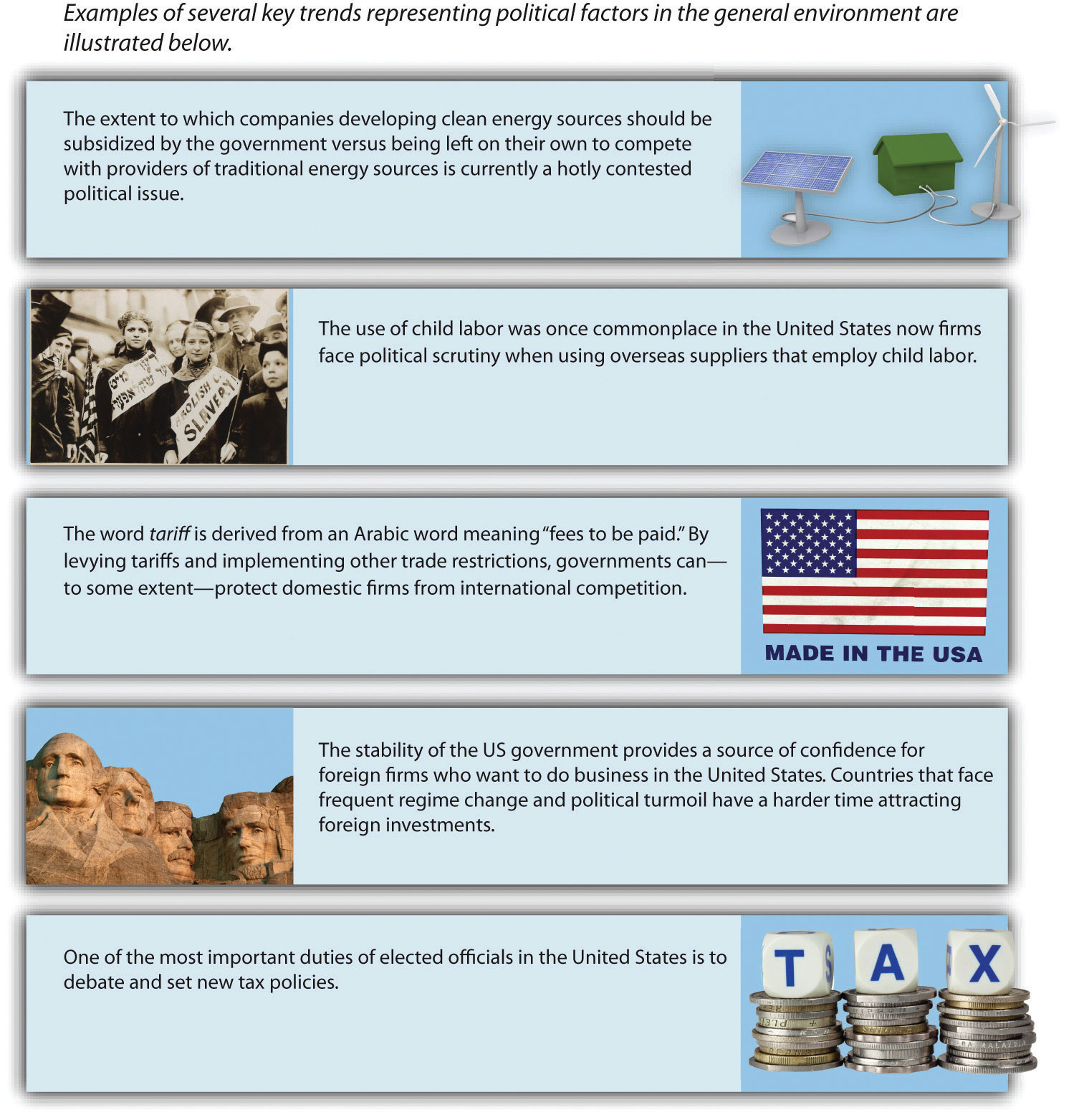
Images courtesy of Bain News Service, http://en.wikipedia.org/wiki/File:Abolish_child_slavery.jpg (second); other images © Thinkstock.
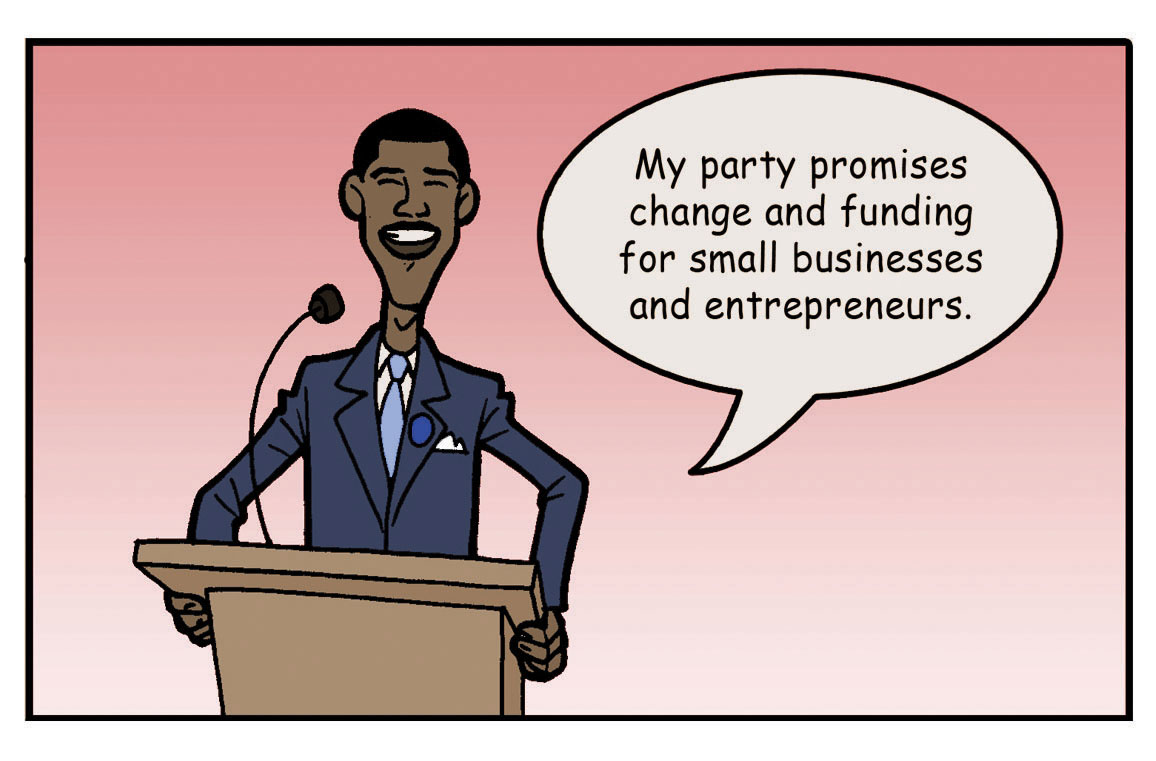
Proposals to provide support to businesses are often featured within political campaigns.
Reproduced with permission from Short, J. C., Bauer, T., Ketchen, D. J., & Simon, L. 2011. Atlas Black: The Complete Adventure. Irvington, NY: Flat World Knowledge.
Meanwhile, farmers argue that a tightening of immigration policy would be harmful because farmers rely heavily on cheap labor provided by illegal immigrants. In particular, if farmers were forced to employ only legal workers, this would substantially increase the cost of vegetables. Restaurant chains such as Subway would then pay higher prices for lettuce, tomatoes, and other perishables. Subway would then have to decide whether to absorb these costs or pass them along to customers by charging more for subs. Overall, any changes in immigration policy will have implications for hospitals, farmers, restaurants, and many other organizations.
E Is for “Economic”
The economic segmentThe portion of the general environment that involves economic and financial conditions. centers on the economic conditions within which organizations operate. It includes elements such as interest rates, inflation rates, gross domestic product, unemployment rates, levels of disposable income, and the general growth or decline of the economy (Figure 3.3 "Economic Factors"). The economic crisis of the late 2000s has had a tremendous negative effect on a vast array of organizations. Rising unemployment discouraged consumers from purchasing expensive, nonessential goods such as automobiles and television sets. Bank failures during the economic crisis led to a dramatic tightening of credit markets. This dealt a huge blow to home builders, for example, who saw demand for new houses plummet because mortgages were extremely difficult to obtain.
Figure 3.3 Economic Factors
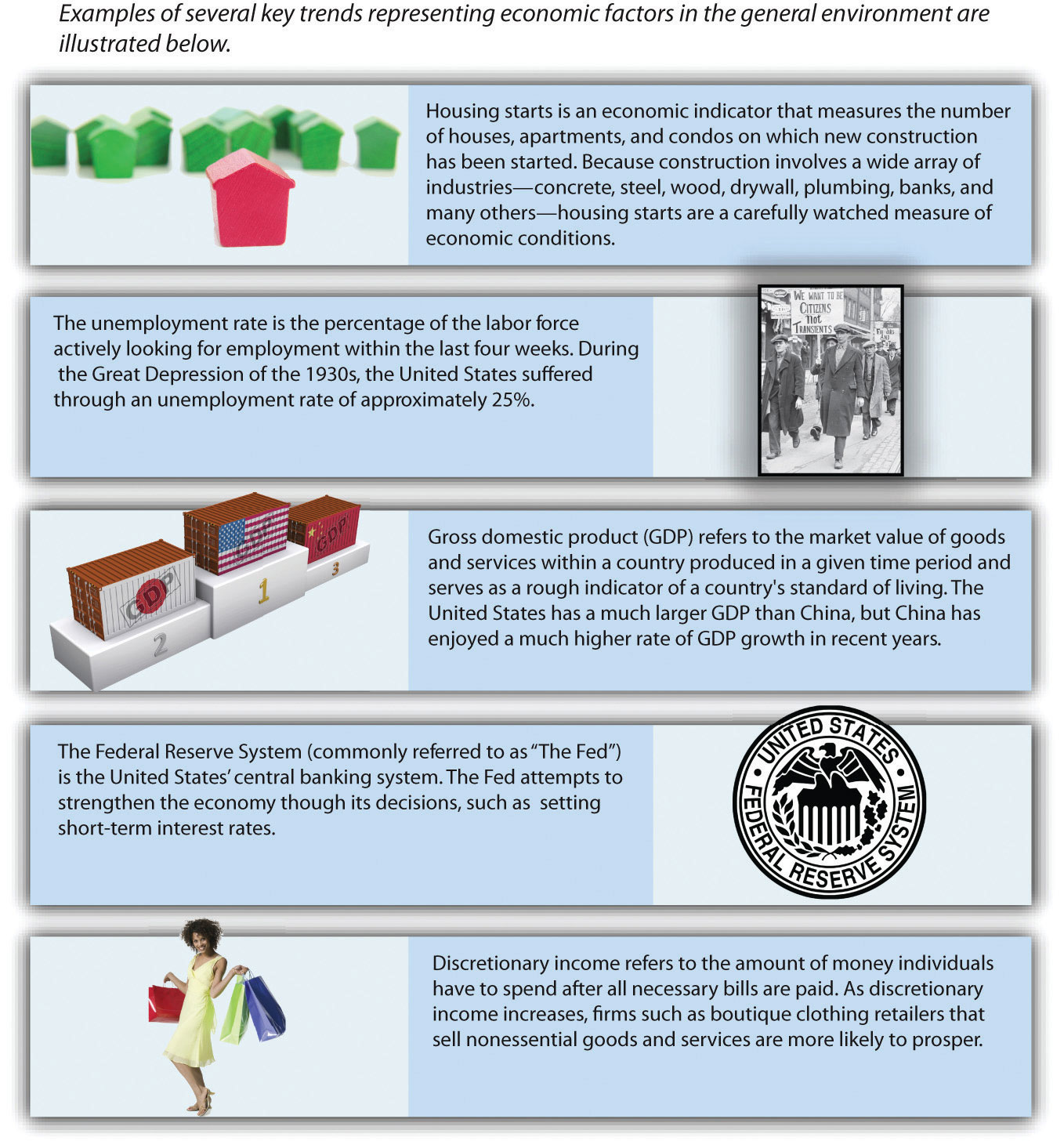
Images courtesy of the US government, http://commons.wikimedia.org/wiki/File:US-FederalReserveSystem-Seal.svg (fourth); http://commons.wikimedia.org/wiki/File:UnemployedMarch.jpg (second); other images © Thinkstock.
Some businesses, however, actually prospered during the crisis. Retailers that offer deep discounts, such as Dollar General and Walmart, enjoyed an increase in their customer base as consumers sought to find ways to economize. Similarly, restaurants such as Subway that charge relatively low prices gained customers, while high-end restaurants such as Ruth’s Chris Steak House worked hard to retain their clientele.
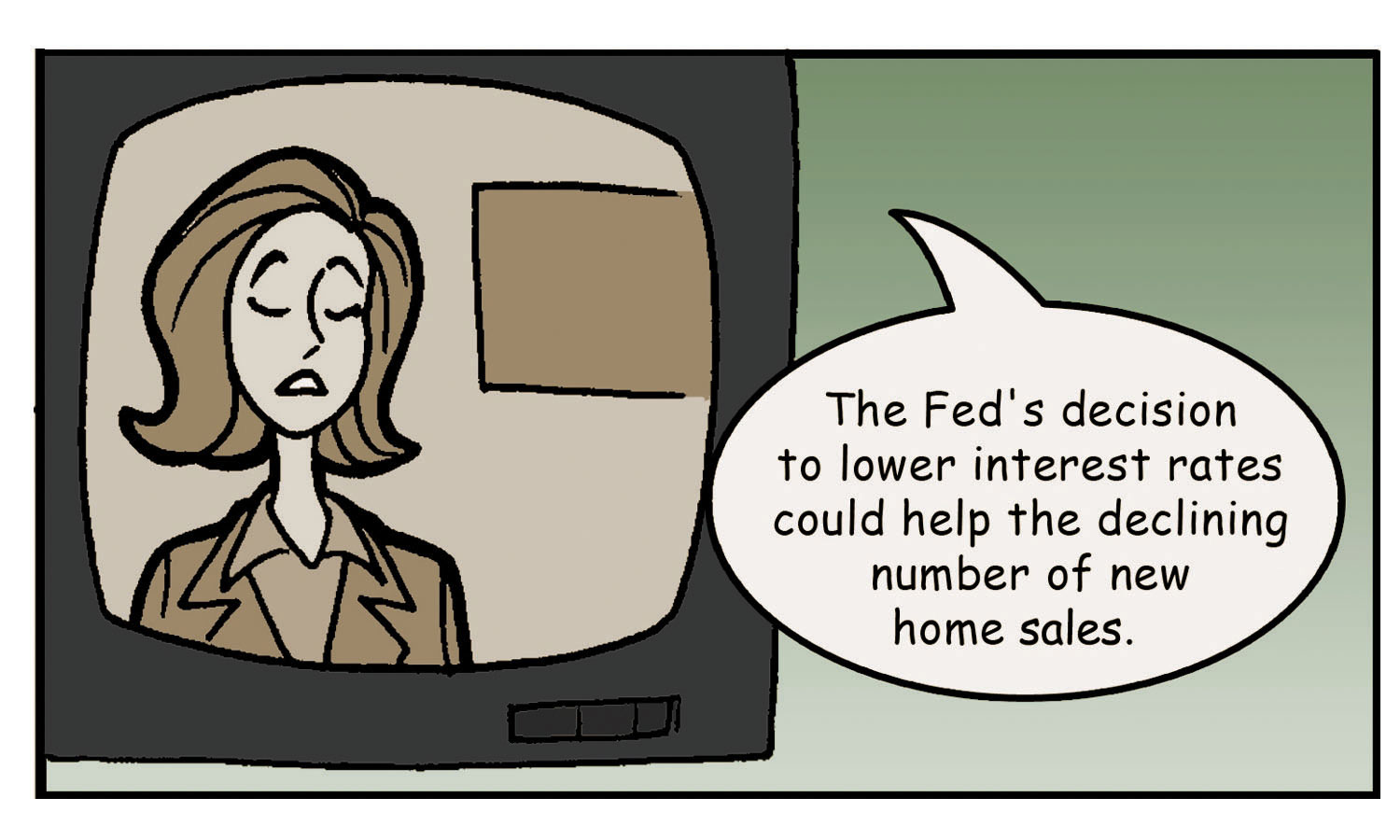
Decisions about interest rates made by the Federal Reserve create opportunities for some organizations and threats for others.
Reproduced with permission from Short, J. C., Bauer, T., Ketchen, D. J., & Simon, L. 2011. Atlas Black: The Complete Adventure. Irvington, NY: Flat World Knowledge.
S Is for “Social”
A generation ago, ketchup was an essential element of every American pantry and salsa was a relatively unknown product. Today, however, food manufacturers sell more salsa than ketchup in the United States. This change reflects the social segmentThe portion of the general environment that involves demographics and cultural trends. of the general environment. Social factors include trends in demographics such as population size, age, and ethnic mix, as well as cultural trends such as attitudes toward obesity and consumer activism (Figure 3.4 "Social Factors"). The exploding popularity of salsa reflects the increasing number of Latinos in the United States over time, as well as the growing acceptance of Latino food by other ethnic groups.
Figure 3.4 Social Factors
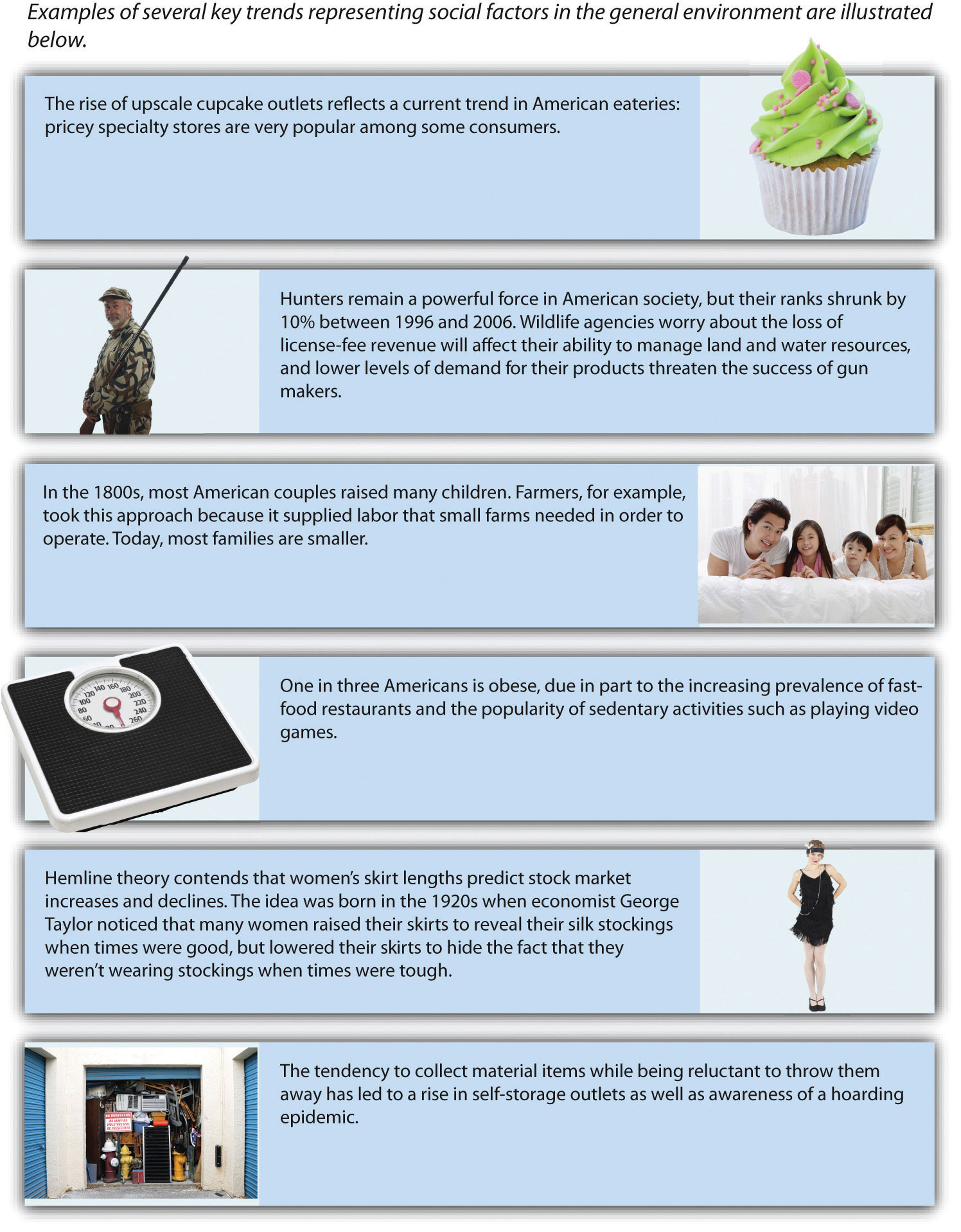
© Thinkstock
Sometimes changes in the social segment arise from unexpected sources. Before World War II, the American workforce was overwhelmingly male. When millions of men were sent to Europe and Asia to fight in the war, however, organizations had no choice but to rely heavily on female employees. At the time, the attitudes of many executives toward women were appalling. Consider, for example, some of the advice provided to male supervisors of female workers in the July 1943 issue of Transportation Magazine:1943 guide to hiring women. 2007, September–October. Savvy & Sage, p. 16.
- Older women who have never contacted the public have a hard time adapting themselves and are inclined to be cantankerous and fussy. It’s always well to impress upon older women the importance of friendliness and courtesy.
- General experience indicates that “husky” girls—those who are just a little on the heavy side—are more even tempered and efficient than their underweight sisters.
- Give every girl an adequate number of rest periods during the day. You have to make some allowances for feminine psychology. A girl has more confidence and is more efficient if she can keep her hair tidied, apply fresh lipstick and wash her hands several times a day.
The tremendous contributions of female workers during the war contradicted these awful stereotypes. The main role of women who assembled airplanes, ships, and other war materials was to support the military, of course, but their efforts also changed a lot of male executives’ minds about what females could accomplish within organizations if provided with opportunities. Inequities in the workplace still exist today, but modern attitudes among men toward women in the workplace are much more enlightened than they were in 1943.
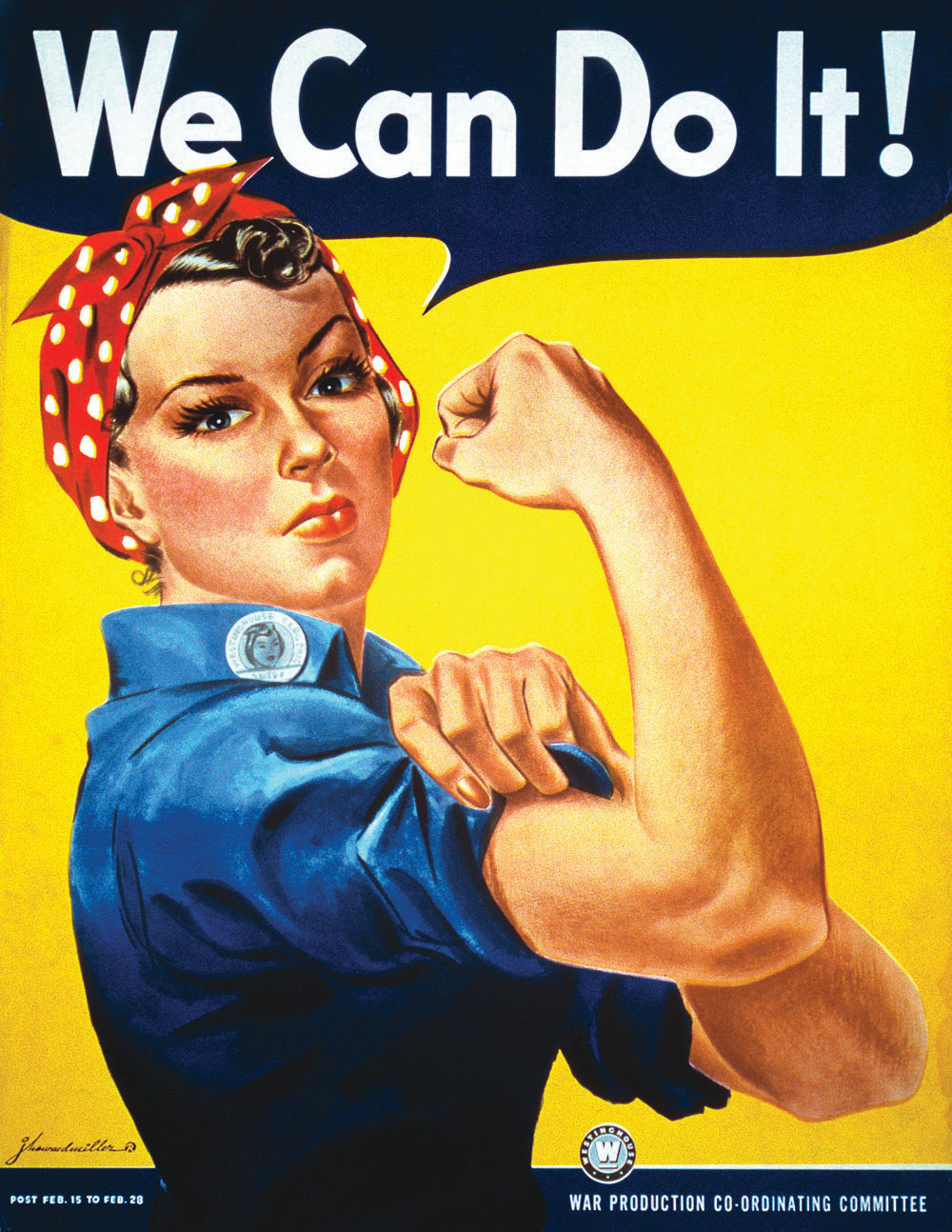
Women’s immense contributions to the war effort during World War II helped create positive social changes in the ensuing decades.
Image courtesy of J. Howard Miller, http://en.wikipedia.org/wiki/File:We_Can_Do_It!.jpg.
Beyond being a positive social change, the widespread acceptance of women into the workforce has created important opportunities for certain organizations. Retailers such as Talbot’s and Dillard’s sell business attire to women. Subway and other restaurants benefit when the scarceness of time lead dual income families to purchase take-out meals rather than cook at home.

A surprising demographic trend is that both China and India have more than twice as many English-speaking college graduates each year than does the United States.
Reproduced with permission from Short, J. C., Bauer, T., Ketchen, D. J., & Simon, L. 2011. Atlas Black: The Complete Adventure. Irvington, NY: Flat World Knowledge.
T Is for “Technological”
The technological segmentThe portion of the general environment that involves scientific advances. centers on improvements in products and services that are provided by science. Relevant factors include, for example, changes in the rate of new product development, increases in automation, and advancements in service industry delivery (Figure 3.5 "Technological Factors"). One key feature of the modern era is the ever-increasing pace of technological innovation. In 1965, Intel cofounder Gordon E. Moore offered an idea that has come to be known as Moore’s law. Moore’s law suggests that the performance of microcircuit technology roughly doubles every two years. This law has been very accurate in the decades since it was offered.
Figure 3.5 Technological Factors
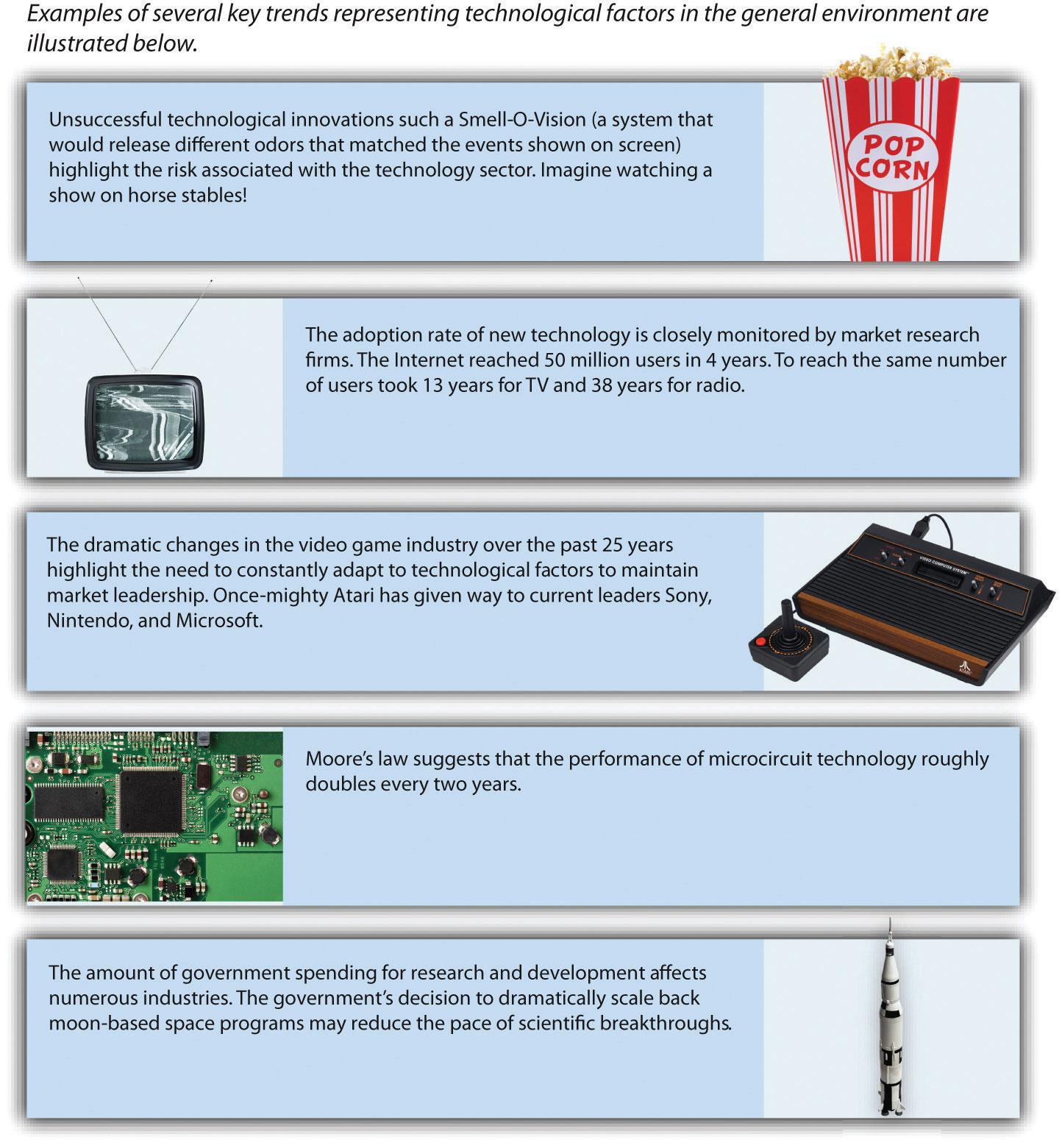
Images courtesy of Evan-Amos, http://commons.wikimedia.org/wiki/File:Atari-2600-Wood-4Sw-Set.jpg (third); other images © Thinkstock.
One implication of Moore’s law is that over time electronic devices can become smaller but also more powerful. This creates important opportunities and threats in a variety of settings. Consider, for example, photography. Just a decade ago, digital cameras were relatively large and they produced mediocre images. With each passing year, however, digital cameras have become smaller, lighter, and better. Today, digital cameras are, in essence, minicomputers, and electronics firms such as Panasonic have been able to establish strong positions in the market. Meanwhile, film photography icon Kodak has been forced to abandon products that had been successful for decades. In 2005, the firm announced that it would stop producing black-and-white photographic paper. Four years later, Kodachrome color film was phased out.
Successful technologies are also being embraced at a much faster rate than in earlier generations. The Internet reached fifty million users in only four years. In contrast, television reached the same number of users in thirteen years while it took radio thirty-eight years. This trend creates great opportunities for organizations that depend on emerging technologies. Writers of applications for Apple’s iPad and other tablet devices, for example, are able to target a fast-growing population of users. At the same time, organizations that depend on technologies that are being displaced must be aware that consumers could abandon them at a very rapid pace. As more and more Internet users rely on Wi-Fi service, for example, demand for cable modems may plummet.

Moore’s law explains how today’s iPhone can be one hundred times faster, one hundred times lighter, and ten times less expensive than a “portable” computer built in the 1980s.
Image courtesy of Evolution, http://en.wikipedia.org/wiki/File:Osborne_Executive_with_iPhone_in_2009.jpg.
Although the influence of the technological segment on technology-based companies such as Panasonic and Apple is readily apparent, technological trends and events help to shape low-tech businesses too. In 2009, Subway started a service called Subway Now. This service allows customers to place their orders in advance using text messages and avoid standing in line at the store. By offering customers this service, Subway is also responding to a trend in the general environment’s social segment: the need to save time in today’s fast-paced society.
E Is for “Environmental”
The environmental segmentThe portion of the general environment that involves the natural environment. involves the physical conditions within which organizations operate. It includes factors such as natural disasters, pollution levels, and weather patterns (Figure 3.6 "Environmental Factors"). The threat of pollution, for example, has forced municipalities to treat water supplies with chemicals. These chemicals increase the safety of the water but detract from its taste. This has created opportunities for businesses that provide better-tasting water. Rather than consume cheap but bad-tasting tap water, many consumers purchase bottled water. Indeed, according to the Beverage Marketing Corporation, the amount of bottled water consumed by the average American increased from 1.6 gallons in 1976 to 28.3 gallons in 2006.Plastic recycling facts. earth911.com. Retrieved from http://earth911.com/recycling/plastic/plastic-bottle-recycling-facts At present, roughly one-third of Americans drink bottled water regularly.
Figure 3.6 Environmental Factors
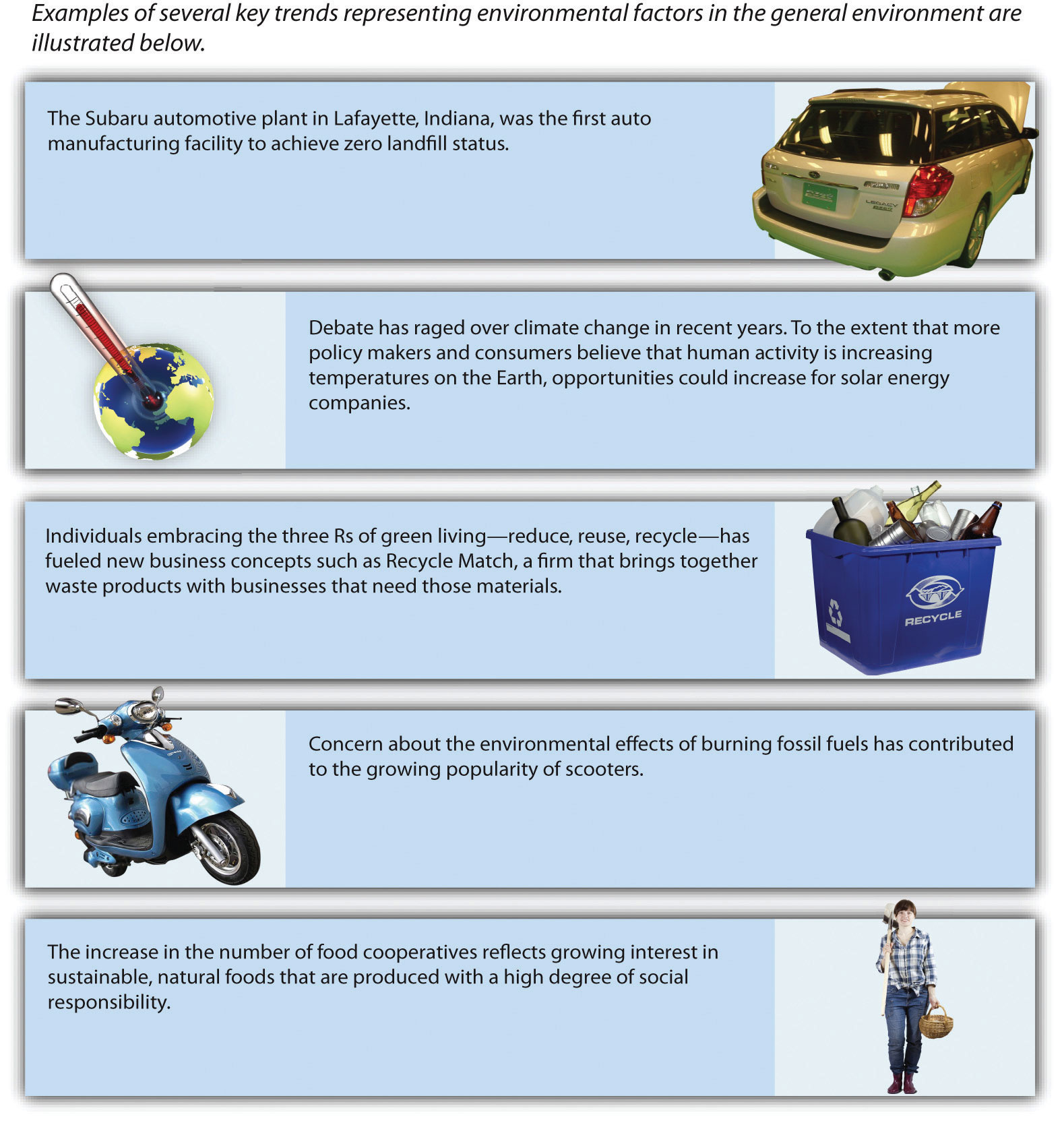
Images courtesy of Cowboydave 1, http://commons.wikimedia.org/wiki/File:City_cut_out.jpg (fourth); Bull-Doser, http://commons.wikimedia.org/wiki/File:%2709_Subaru_Legacy_Wagon_PZEV_%28MIAS%29.JPG (first); other images © Thinkstock.
As is the case for many companies, bottled water producers not only have benefited from the general environment but also have been threatened by it. Some estimates are that 80 percent of plastic bottles end up in landfills. This has led some socially conscious consumers to become hostile to bottled water. Meanwhile, water filtration systems offered by Brita and other companies are a cheaper way to obtain clean and tasty water. Such systems also hold considerable appeal for individuals who feel the need to cut personal expenses due to economic conditions. In sum, bottled water producers have been provided opportunities by the environmental segment of the general environment (specifically, the spread of poor-tasting water to combat pollution) but are faced with threats from the social segment (the social conscience of some consumers) and the economic segment (the financial concerns of other consumers).

A key trend within the environmental segment is an increasing emphasis on conserving fossil fuels.
Reproduced with permission from Short, J. C., Bauer, T., Ketchen, D. J., & Simon, L. 2011. Atlas Black: The Complete Adventure. Irvington, NY: Flat World Knowledge.
L Is for “Legal”
The legal segmentThe portion of the general environment that involves the law and courts. centers on how the courts influence business activity. Examples of important legal factors include employment laws, health and safety regulations, discrimination laws, and antitrust laws (Figure 3.7 "Legal Factors").
Intellectual property rightsThe ability of an organization to protect intangible goods such as movies, software, and video games from piracy. are a particularly daunting aspect of the legal segment for many organizations. When a studio such as Pixar produces a movie, a software firm such as Adobe revises a program, or a video game company such as Activision devises a new game, these firms are creating intellectual property. Such firms attempt to make profits by selling copies of their movies, programs, and games to individuals. Piracy of intellectual property—a process wherein illegal copies are made and sold by others—poses a serious threat to such profits. Law enforcement agencies and courts in many countries, including the United States, provide organizations with the necessary legal mechanisms to protect their intellectual property from piracy.
Figure 3.7 Legal Factors
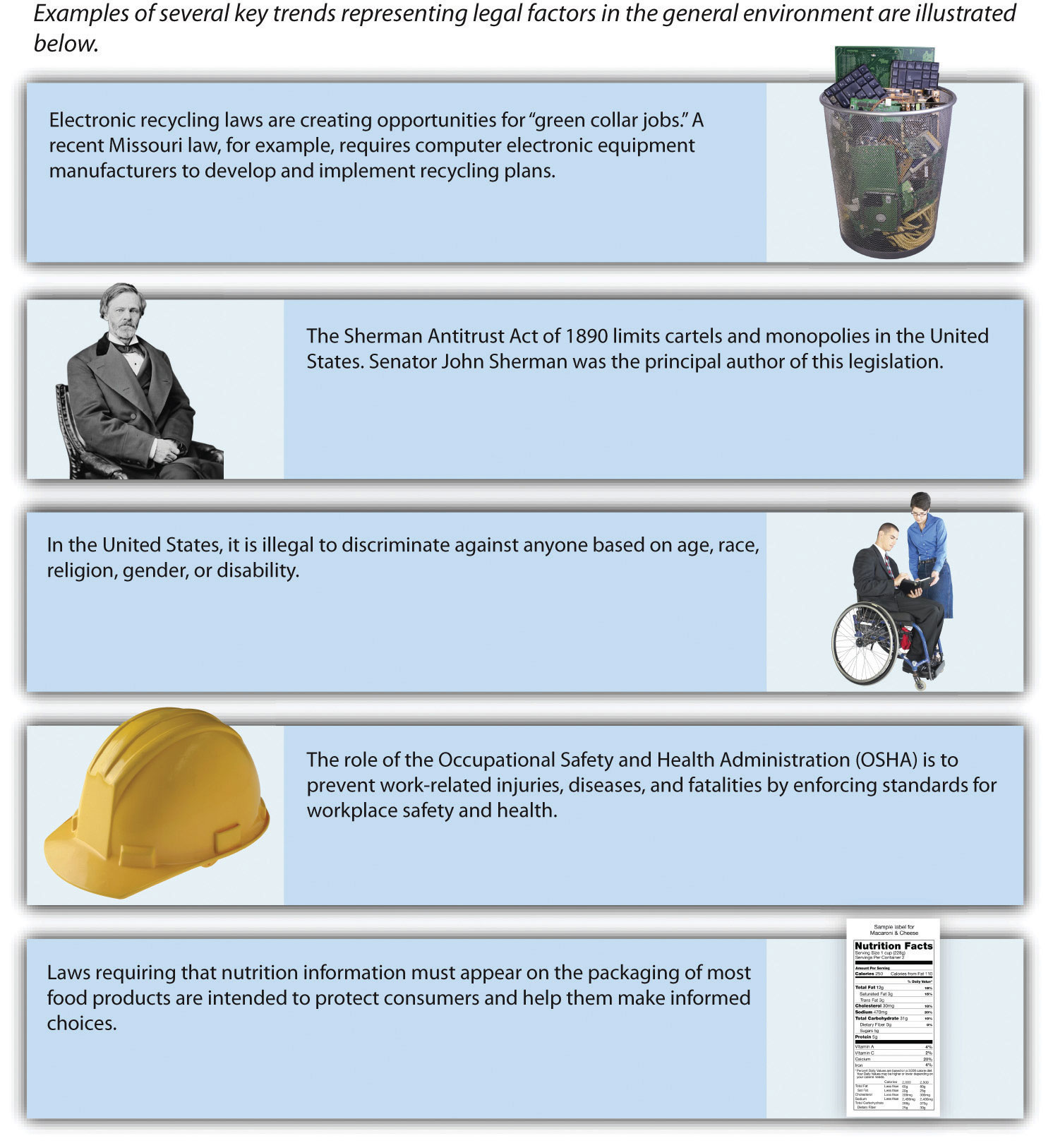
Images courtesy of Trounce, http://commons.wikimedia.org/wiki/File:US_Nutritional_Fact_Label.svg (fifth); Mathew Brady and Levin Corbin Handy, http://commons.wikimedia.org/wiki/File:John-Sherman-2.jpg (second); other images © Thinkstock.
In other countries, such as China, piracy of intellectual property is quite common. Three other general environment segments play a role in making piracy a major concern. First, in terms of the social segment, China is the most populous country in the world. Second, in terms of the economic segment, China’s affluence is growing rapidly. Third, in terms of the technological segment, rapid advances in computers and communication have made piracy easier over time. Taken together, these various general environment trends lead piracy to be a major source of angst for firms that rely on intellectual property to deliver profits.
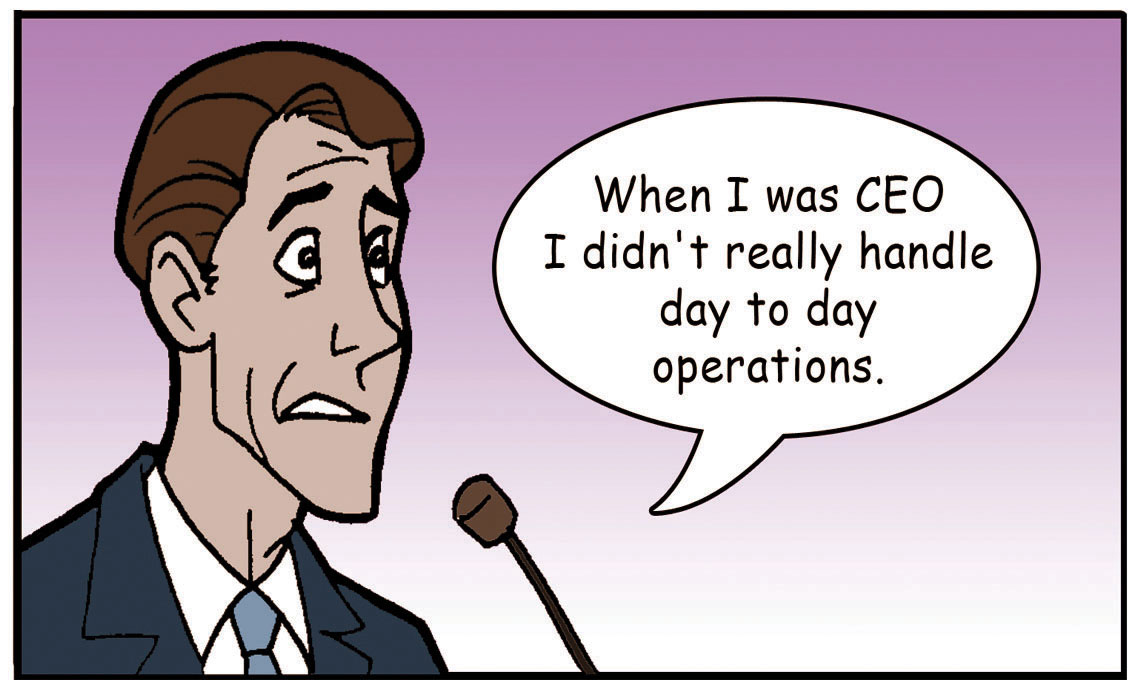
A key legal trend in recent years is forcing executives to have greater accountability for corporate misdeeds via laws such as the 2002 Sarbanes-Oxley Act.
Reproduced with permission from Short, J. C., Bauer, T., Ketchen, D. J., & Simon, L. 2011. Atlas Black: The Complete Adventure. Irvington, NY: Flat World Knowledge.
Key Takeaway
- To transform an avocado into guacamole, a chef may choose to use a mortar and pestle. A mortar is a mashing device that is shaped liked a baseball bat, while a pestle is a sturdy bowl within which the mashing takes place. Similarly, PESTEL reflects the general environment factors—political, economic, social, technological, environmental, and legal—that can crush an organization. In many cases, executives can prevent such outcomes by performing a PESTEL analysis to diagnose where in the general environment important opportunities and threats arise.

Just as a mortar and pestle are used to crush food, PESTEL can crush an organization.
© Thinkstock
Exercises
- What does each letter of PESTEL mean?
- Using a recent news article, identify a trend that has a positive and negative implication for a particular industry.
- Can you identify a general environment trend that has positive implications for nursing homes but negative implications for diaper makers?
- Are all six elements of PESTEL important to every organization? Why or why not?
- What is a key trend for each letter of PESTEL and one industry or firm that would be affected by that trend?




